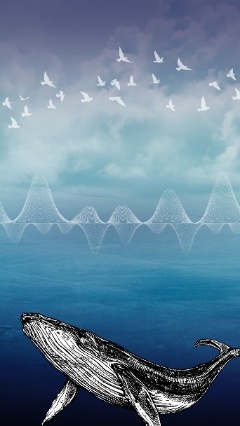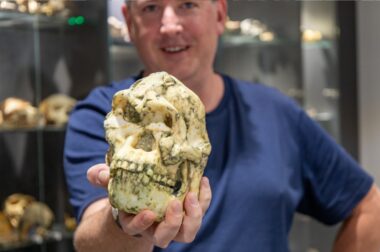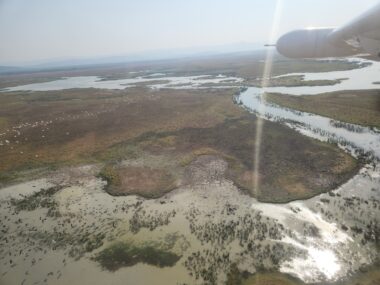Birds soar high in poll to identify Australia’s favourite animal sound.
Banjo frog hops into the top 10. Cicada holds tight.
Is your favourite still singing? Or did it ‘croak’?
Vote now for your favourite from the remaining animal calls.
Media release: 11 August 2023
Media contacts: Laura Boland, [email protected] or 0408 166 426; or Tanya Ha, [email protected] or 0404 083 863.
Full media kit: www.scienceinpublic.com.au/abc/
Participate at: www.abc.net.au/sounds.
Over 90,000 voters have made their voices heard in the search for Australia’s Favourite Animal Sound.
Birds perch high in the top 10, with voters expressing their affection for the songs of the magpie, kookaburra, lyrebird, whipbird, butcherbird, black cockatoo, boobook and the fairy wren.
“It’s not surprising to see so many birds on the list,” says Dr Dominique Potvin, a behavioural ecologist and senior lecturer in animal ecology at the University of the Sunshine Coast.
“I’m just so intrigued that songbirds have to learn their vocalisations in order to communicate with each other. Only a handful of animals can do this, including ourselves. That gives us a special connection to songbirds, and makes me appreciate their acoustic intelligence,” says Dominique.
Also nestled in the top 10 are the ‘bonk bonk’ of the banjo frog and the summery ‘screeeeee’ of the cicada.
“Australian animals provide the soundtracks to our lives,” says Dr Jodi Rowley, a conservation biologist specialising in amphibians at the Australian Museum and UNSW.
“From the dawn chorus that celebrates the sunrise, to the constant hum of cicadas in summer, to the cacophony of calling frogs after rains – they’re an integral part of our lives, tying us to places and times,” says Jodi.
Some of the least favourite bird calls falling off the original list of 28 animal sounds were the raven, koel, gang-gang cockatoo and the sulphur-crested cockatoo.
And the frightening, growling or grumbling sounds of the brushtail possum, koala, Tasmanian devil and gliders fell on hard ears instead of winning hearts, and have dropped off the list of favourites.
The poll is open for the second and final round of voting, with the winner announced on Friday 18 August.
To hear and vote on each remaining animal, visit www.abc.net.au/sounds.
Australia’s Favourite Animal Sound is the online project for National Science Week 2023, undertaken by ABC Science with funding through the Australian Government’s Inspiring Australia strategy.
Download top 10 animal sounds audio here. Talent available for interviews.
Australia’s Favourite Animal Sound: Top 10 (alphabetical order by common name)
Banjo frog or ‘pobblebonk’ (Limnodynastes species): “bonk bonk”
Boobook/Guurrguurr (Ninox boobook and Ninox leucopsis): “book book” or “mo-poke”
Black cockatoo (Zanda funerea): “kee-ow”
Butcherbird (Cracticus torquatus and Cracticus nigrogularis): melodic and maniacal
Cicadas (superfamily Cicadoidea): “screeeeee”
Fairywren (Malurus species): high tinkering trills
Kookaburra (Dacelo novaeguineae): “koo-koo-koo-koo-koo-kaa-kaa-kaa”
Lyre bird (Menura novaehollandiae): a famous mimic
Magpie (Gymnorhina tibicenhas): melodious carolling
Whipbird (Psophodes olivaceus): whipcrack followed by “choo-choo”
Media contacts:
- Laura Boland, [email protected] or 0408 166 426
- Tanya Ha, [email protected] or 0404 083 863.

Dr Jodi Rowley is a conservation biologist obsessed with amphibians. Now based at the Australian Museum and the University of New South Wales in Sydney, she has led many expeditions in search of amphibians in Australia and Southeast Asia. Jodi is the Lead Scientist of FrogID, a national citizen science project developed by the Australian Museum that has collected almost 1 million records of frogs across Australia since 2017.
Dr Dominique Potvin is a behavioural ecologist and senior lecturer in Animal Ecology at the University of the Sunshine Coast. She specialises in bioacoustics, especially birdsong, and how animal communication is impacted by human activities. She loves integrating behaviour, physiology, genetics, neurobiology and ecology to take a big-picture look at how vertebrates respond to human-made noise and other aspects of global change.
Associate Professor Jen Martin is a scientist (a wildlife ecologist by training), leads the science communication teaching program at the University of Melbourne, is a radio broadcaster on Triple R Breakfasters and Einstein A Go Go, blogger, podcaster and science writer.
Dr Karl Kruszelnicki is a qualified scientist, doctor and engineer whose fun-loving personality led him to become a well-known author, science communicator and ABC regular. He is the Julius Sumner Miller Fellow at the University of Sydney.
Quotes from animal sound experts available for use:
Quotes attributed to Dr Dominique Potvin, The University of the Sunshine Coast
“One of the most amazing things to many people about getting out of the bustling city is hearing the natural world. Whether you can recognise every single species, or you just appreciate your surroundings, there is something that happens in our brains when we escape the low rumble of human-made noise daily and immerse ourselves in natural soundscapes.
Quotes attributed to Dr Jodi Rowley, The Australian Museum and the University of New South Wales
“It can be easy to get caught up in the human-made sounds of a city – the hum of traffic or the beat of music – but the sounds of nature are around us, even in the city. Animals are communicating all around us –sometimes their sounds are familiar, and sometimes unexpectedly bizarre.
“We can learn so much by tuning in to the sounds of animals around us – the calls of frogs can alert us to the onset of the monsoon rains, the arrival of particular birds to the change of season, and disappearance or arrival of certain species can be telling of changes in local environment health.”
Quote attributed to Anthony Albrecht, musician and PhD Candidate at Charles Darwin University studying the impact of environmental art on audience attitudes and behaviour.
“Our natural soundscape shapes our identity as Australians. The loss of these sounds, while unimaginable, is a grim reality we will all face in the very near future without taking action. While celebrating our favourite animal sounds, we need to consider the precarious position of our biodiversity and advocate for stronger protection for these special creatures.”
Quotes attributed to Brad Law, Principal Research Scientist, Dept of Primary Industries NSW.
“Nature sounds are highly evocative and I’m particularly drawn to the sounds of nocturnal animals when all is quiet and most people are tucked up in bed. There’s nothing quite like being out in the forest at night and hearing other-worldly screams and screeches, but at the same time feeling relief that those species are still going about their business, largely hidden from prying human eyes.”
“Our wildlife not only produce an array of wonderful sounds, but they are becoming increasingly useful for ecologists, as technology is now able to capture and process much of this information; leading to an improved understanding of otherwise difficult-to-see animals. This technology is turning out to be a game changer in helping us monitor the changing status of many species.”
Quote attributed to Dr Nicola Hanrahan, postdoctoral research fellow at Charles Darwin University
“What I find fascinating is that these sounds are animals communicating with each other, whether that be to woo a mate, warn of danger, or beg for food. Listening to animal sounds is one of the ways that we can monitor the health of Australian species and the environment as a whole.”


